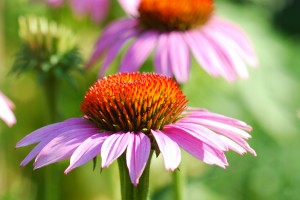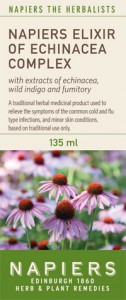 The change of seasons always seems to bring about colds in my family. As a teacher, I am repeatedly exposed to sniffles and coughs. Even though I think I will build up immunity after so many illnesses, there is always a new strain that attacks my immune system.
The change of seasons always seems to bring about colds in my family. As a teacher, I am repeatedly exposed to sniffles and coughs. Even though I think I will build up immunity after so many illnesses, there is always a new strain that attacks my immune system.
When I first started learning about herbal medicine twenty years ago, echinacea was the first immune boosting herb I started using. Now, at the first signs of illness, echinacea starts my treatment. I am so thankful for its healing properties!
This beautiful flower found commonly in flower beds and native to the prairies of the United States is also known as the coneflower. It is related to the daisy.
Traditional Native American medicine relied on its effectiveness, as we do today. The University of Maryland Medical Center explains:
Archaeologists have found evidence that Native Americans may have used echinacea for more than 400 years to treat infections and wounds and as a general “cure-all.” Throughout history people have used echinacea to treat scarlet fever, syphilis, malaria, blood poisoning, and diphtheria. Although this herb was popular during the 18th and 19th centuries, its use began to decline in the United States after the introduction of antibiotics. Echinacea preparations became increasingly popular in Germany throughout the 20th century. In fact, most of the scientific research on echinacea has been conducted in Germany.
Today, people use echinacea to shorten the duration of the common cold and flu and reduce symptoms, such as sore throat (pharyngitis), cough, and fever. Many herbalists also recommend echinacea to help boost the immune system and help the body fight infections.
The power of echinacea in fighting springtime colds and allergies
 This powerful, popular herb can also assist with springtime allergies, especially hay fever (allergic rhinitis). Fortunately, I don’t suffer from allergies, but I do suffer from colds quite often. My herbal medicine chest is always stocked with echinacea, like echinacea from Napiers.
This powerful, popular herb can also assist with springtime allergies, especially hay fever (allergic rhinitis). Fortunately, I don’t suffer from allergies, but I do suffer from colds quite often. My herbal medicine chest is always stocked with echinacea, like echinacea from Napiers.
What it does
- Used at the first sign of catarrh, runny nose and cold-type symptoms, it helps to prevent infections from developing
- Helps relieve minor skin conditions such as mild acne and boils
- Helps relieve the symptoms of mild eczema and allergic dermatitis
This hiqh quality product uses the root, which is definitely something you want to look for when purchasing echinacea. Many of the products now commonly available in drug stores use only the flower or a combination of flower and root, which is not nearly as beneficial. Napiers is an elixir combining the benefits of wild indigo and fumitory with echinacea. Fumitory is beneficial for intestinal issues. Wild Indigo has similar properties in fighting flu and cold like symptoms, as well as infections, as echinacea.
When we are sick, it is important that we use products that support our immune system instead of weakening it. Echinacea does this without using pharmaceuticals or artificial flavors or colorings. Antibiotic resistance is real and scary. We need to reserve pharmaceutical medication for extreme need. Echinacea is proven effective in many clinical studies. It is my go to natural remedy!
Image: Echinacea purpurea on Bigstock
I love this herb and we have taken it for years. I recently learned that taking a tablespoon of raw vinegar with a tablespoon of raw honey in a cup of water will help with allergy symptoms tremendously.